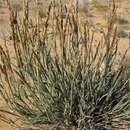en
names in breadcrumbs


Centropodia glauca, also known as ghagras or ikagras[1][2] is a species of grass endemic to Namibia, South Africa, Kenya and Botswana. The occurrence of this grass is proof of well-preserved sandveld. The grass is very hardy and can thrive in dry veld. It is a perennial pole grass that usually grows between 200–850mm but can grow up to 1m tall. The flowering period is between September and May.[3] Because ghagras have few leaves and the stalks are almost always green, it is resistant to fire.[4]
It grows mainly in deep sandy soil, particularly in duneveld; also grows in gravelly soil.[5] It is eaten by game, especially oryx.
It was first described by Christian Gottfried Daniel Nees von Esenbeck, and given its current name by Thomas Arthur Cope.[6]
Centropodia glauca, also known as ghagras or ikagras is a species of grass endemic to Namibia, South Africa, Kenya and Botswana. The occurrence of this grass is proof of well-preserved sandveld. The grass is very hardy and can thrive in dry veld. It is a perennial pole grass that usually grows between 200–850mm but can grow up to 1m tall. The flowering period is between September and May. Because ghagras have few leaves and the stalks are almost always green, it is resistant to fire.
It grows mainly in deep sandy soil, particularly in duneveld; also grows in gravelly soil. It is eaten by game, especially oryx.
It was first described by Christian Gottfried Daniel Nees von Esenbeck, and given its current name by Thomas Arthur Cope.